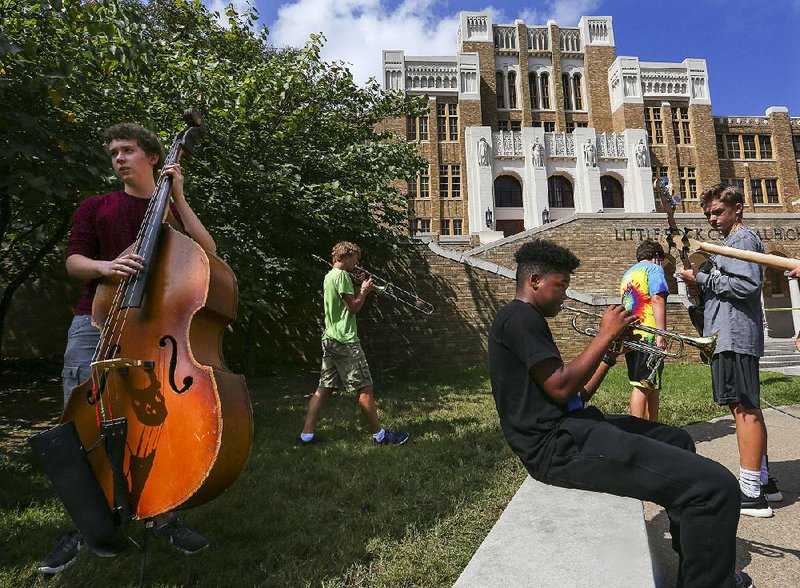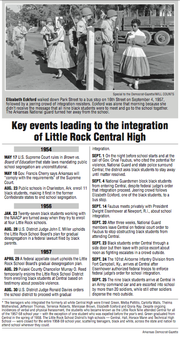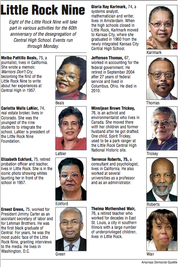Six decades after Arkansas' governor temporarily stopped nine black students from integrating Central High School, the campus is more diverse than ever, its principal said, as other public Little Rock high schools have become increasingly split by race and incomes.
Monday will mark 60 years since nine volunteer students -- Minnijean Brown Trickey, Elizabeth Eckford, Ernest Green, Thelma Mothershed Wair, Melba Pattillo Beals, Gloria Ray Karlmark, Terrence Roberts, Jefferson Thomas and Carlotta Walls LaNier -- became the first black youths to attend a full day of classes at Central High.
The buildup to their first school day attracted worldwide attention. Over the course of the crisis, the youths faced taunts and threats from mobs, their governor dispatched military troops to keep them out and their president dispatched military troops to help them get in. Their ultimate enrollment along with some 2,000 white students -- three years after the U.S. Supreme Court struck down separate-but-equal schools -- stands as a milestone in the national civil-rights movement.
On Monday, all eight of the Little Rock Nine -- Thomas died in 2010 -- will attend a commemoration ceremony in Central High's auditorium. It will be their first reunion since the 50th anniversary commemoration, Wair said.
"We have come a long way since 1957, but we still have a long way to go," Central High Principal Nancy Rousseau said in an email. "Cultural differences and race are always difficult topics, but we have to talk about our differences in order to grow."
As the spotlight returns to Little Rock, the nearly 2,500-student body at Central High School is now ethnically and economically diverse and academically strong, state data show. But other Little Rock School District campuses have far less racial balance, a chasm that has widened during steady districtwide enrollment declines.
The anniversary comes on the heels of Little Rock School District officials settling a discrimination lawsuit filed by black plaintiffs over inequities in school facilities and academic options, and less than two weeks after the state authorized three new independently run charter schools inside the district's boundaries, further increasing competition for students.
The Arkansas Board of Education controls the Little Rock School District, after it ousted the elected School Board nearly three years ago in a takeover prompted by chronically low test scores at six of 48 schools.
"We must never forget the bravery of the Little Rock Nine in the face of bitter opposition and mistreatment," Arkansas Education Commissioner Johnny Key, who serves as the district's School Board, said by email. "Now we rightly honor them as heroes of our state and our nation, and their sacrifice must be remembered for what it means to all students in [the Little Rock School District] as well as every school in Arkansas."
Former President Bill Clinton will deliver Monday's keynote address commemorating the anniversary. The commemoration comes a time when racial discord nationally has flared after police-involved shootings, white-nationalist rallies and debates over the removal of statues depicting Civil War heroes from the Confederacy.
Little Rock City Hall, the National Park Service and the city's tourism bureau have organized several official events that begin today with a sculpture dedication and will culminate with Clinton's speech, under the theme "Reflections of Progress."
A group called Grassroots Arkansas -- which has fought charter school expansion and the state takeover of the Little Rock district -- has unveiled an alternative set of events. Its message is "Sixty Years: Still Fighting."
THE SCHOOL TODAY
On a recent afternoon, Central High School's hallways were covered with campaign posters for student government candidates, as well as signs supporting people whose parents brought them to the United States when they were children and who are now illegal.
Workers applied a fresh coat of paint to walls near a side entrance, while construction workers repaired the school's iconic stairway.
Study hall was in session in the corner of the auditorium, where members of the Little Rock Nine -- now all in their 70s -- will gather Monday.
An Arkansas Democrat-Gazette reporter's glimpse inside Central High was limited to part of one of the National Park Service's twice-daily guided tours of the school. The district's communications director, Pamela Smith, and Rousseau declined requests to allow more access.
Jodi Morris, a native Arkansan, has worked as a Park Service ranger at Central High for eight years. Her father was one of the National Guardsmen stationed at Central High during the 1957 school crisis. At first, on Gov. Orval Faubus' orders, he blocked the students from entering. Then, on President Dwight Eisenhower's orders, he protected the students so they could go in.
She not only researches the school's history, but keeps up with its present, talking with students, graduates and educators.
"The school is, to me, very integrated today and not just racially -- [but] ethnically, linguistically," Morris told a group of people from England, India, Illinois, Connecticut and elsewhere. "The city is more diverse, and the school does reflect that. Not perfectly but more so than, by far, most urban public high schools," she said.
Central High's racial makeup in 2016-17 was 58 percent black, 30 percent white, 7 percent Asian and 5 percent Hispanic, according to Arkansas Department of Education data. Seventeen students were American Indian, and 23 were biracial.
Niche, a website focused on analyzing education data, ranks Central High the second-most diverse school in Arkansas -- behind Northside High in Fort Smith -- and number 616 of 22,335 high schools nationally. The rankings are based on U.S. Department of Education data and surveys of parents and students.
Central High's current racial composition is "surprising," a national researcher with ties to Little Rock said, in light of "rapid resegregation of schools" since a 1991 U.S. Supreme Court decision that federal court desegregation orders are meant to be temporary.
Gary Orfield, co-director of The Civil Rights Project at the University of California, Los Angeles, was co-chairman of a committee that studied Pulaski County desegregation in 1980, he said. The committee's recommendations led to the long-running desegregation case involving three Pulaski County school districts, including the Little Rock district.
"It is kind of surprising that Central High is still biracial after all these years," Orfield said. "I think there ought to be some effort to actually, successfully integrate and keep that school integrated."
Rousseau, who became assistant principal in 1997 and principal in 2007, said Central High students hail from 24 countries and speak 27 different native languages.
"In 1997 and 2007 the school was predominately black and white; we are now far more diverse," Rousseau said. "We are no longer talking just about race. We have a broad community of students whom we support, including students who identify as LGBTQ," using the acronym for lesbian, gay, bisexual, transgender and queer.
Andrea Dixon, who graduated from Central High in 1984, is the mother of a Little Rock campus graduate, a current student and a future student. She praised the global perspective offered at the school.
"I like that they go to school with people from so many different countries, so many different walks of life, so many different backgrounds," Dixon said. "I think Central is a reflection of the world. I think it's important that children can learn where their place is in the world."
LESS-DIVERSE DISTRICT
Little Rock's other public high schools are far less diverse, public data show.
In the 11-year span from the 2006-07 to 2016-17 school years, the Little Rock School District lost 2,700 students, or 10 percent of its enrollment, according to Arkansas Department of Education data.
White student enrollment declined by one-third in that span to 4,100, and black enrollment fell 16 percent to 14,600. If not for the doubling of the Hispanic enrollment to 3,200, the student body losses would be greater.
The recent losses are a continuation of a far-longer trend, Superintendent Mike Poore and others said.
Poore attributed enrollment declines to families moving school-aged children to places like Bryant, Cabot and other towns outside Pulaski County. Meanwhile, the continued expansion of charter schools in Little Rock increases competition for students, he said.
Jim Ross, a University of Arkansas at Little Rock history professor who was elected to the School Board before the state's takeover, is co-writing a book about race in the Little Rock district in the decades "after the cameras left." He said Little Rock "desegregated" its schools beginning in 1957, but the city "didn't try integration."
In the late 1970s, the school district had a black-white racial balance close to 50-50 and it appeared to be integrated, Ross said.
"But the real narrative -- if you put everything in order -- is that since '57, whites have been fleeing the Little Rock School District, leaving us with a majority black, now Latino, school district," he said.
White students in the 2016-17 school year made up 16 percent of the district's enrollment in a city where the population is 52 percent white.
Of the 1,100 white students enrolled in Little Rock's public high schools last year, 67 percent attended Central High. Another 21 percent attended Parkview Arts and Science Magnet High School, the city's only high school that does not have an attendance zone. Students from across the district apply to enroll at Parkview and are selected in a lottery.
Central High's attendance zone includes areas west of Interstate 430 and east of Interstate 30. Its attendance zone is the only one of the school district's four that is not contiguous -- a segment of west Little Rock is included in the zone but doesn't directly connect to it.
Plaintiffs in court filings for the recently settled Doe v. Key discrimination lawsuit called the zone "racially gerrymandered" to maximize white student attendance. As part of the settlement, the district committed to creating new high school attendance zones "based on a written, race-neutral rationale," but Poore said he expects no major changes to the Central High attendance zone.
"When you have boundaries in place for a long time, there's ownership in those communities," Poore said. "Parents feel like there are options and choice [outside of the district]. We want to make sure the decisions we make maintain our numbers and we don't lose students."
Each of Little Rock's other three high schools that have specific attendance zones -- Hall, J.A. Fair and McClellan -- were considered to be in academic distress because of low test scores before the state takeover. J.A. Fair and McClellan have since been removed from the academic-distress list.
Students at J.A. Fair and McClellan were overwhelmingly black in 2016-17 -- 87 percent and 89 percent, respectively -- according to state data. Hall's student population was 64 percent black and 29 percent Hispanic. White students made up 4 percent of the three schools' combined 2,800 enrollment, down from 8 percent 11 years earlier.
"I don't necessarily view it as cause for concern," Poore said of the numbers. "I don't really care what color skin and what backgrounds the students have. We just want to serve more students."
Every student at those three schools in 2015-16 was considered low-income, according to the most current Education Department report cards. At Central and Parkview high schools, 47 percent and 53 percent of the students were low-income.
When asked about the racial disparity and Central High's attendance zone, Key referred to the district's planned $90 million high school in southwest Little Rock. The new school will rival Central in enrollment, and replace McClellan and Fair and draw hundreds of students from Hall.
"There will soon be a new world-class high school in southwest Little Rock, and I know Superintendent Poore will see that the quality of the learning experience there matches the quality of the facility," Key said by email. "I have confidence that in the coming years every [public Little Rock] high school will be one where students and families will want to be, thus the attendance zones won't be a major concern."
Standardized ACT Aspire test results at McClellan, Fair and Hall high schools from this spring show that at least 86 percent of 10th-graders at each campus were reading below grade level, at least 91 percent fell short of science benchmarks and at least 95 percent were below grade level in math.
"If you're a black child in the Little Rock School District, you are more than likely not reading at college-ready level," Ross said.
Tenth-graders at Central High School, meanwhile, fared better in most subjects on average than their statewide peers. Results show that 64 percent of Central High students were at grade level in English, 42 percent in reading, 37 percent in science and 29 percent in math.
Morris, the National Park Service ranger, said she views the 60th anniversary of Central High's desegregation as a time to reflect on whether students in integrated schools are receiving equitable educations.
"People get frustrated," Morris said. "When's it going to be over? When are we going to stop talking about Central High desegregation [by] the Little Rock Nine? The answer is we won't, and I hope we don't, because it does help guide us in that next step. OK, we've got the schools integrated by law. How do we make sure every child has an opportunity?"
RELATED ARTICLE
http://www.arkansas…">Anniversary events range from art to panels
Metro on 09/22/2017




